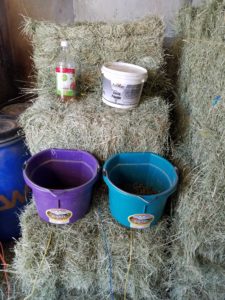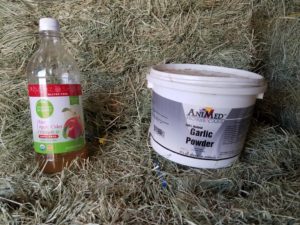If you ask a horse owner “what should I feed my horse?” you’ll get as many different answers as there are colors of horses and then some. Every one has their own opinions: some are rooted in research, others aren’t, some are done because that’s the way it’s always been done, and others can’t seem to find a reason but that’s just what they do.
We’ve come a long way in equine nutrition since the days where horses were building civilization. There is much research to be found about different forage varieties, supplements, vitamins, and other concoctions. Growing up I attended horse seminar after horse seminar with my Mom. I took in all kinds of information about horses: safety, anatomy, wound care, disease, tack fitting, and nutrition. My mom has always done as much research as she can for the welfare of our animals.
My mom and I feed our horses nearly the same things. My feed regime is catered to my horses, especially Mr. Picky-Pants (Flint McCoy) as any animal’s diet should be. What is below is my opinions based off advice from my horse’s vets, my incredible mom, and my own research.

Pictured is my “big horse” feed set up. The minis have their forage stored with my big horse’s feed, however, their “grain” is near their pen. I use the term grain loosely as none of my horses get true grain, instead they all have some type of pelleted feed or combination of different pellets.
Forage for all my horses consists of Bermuda grass hay. I know there are many horse owners who choose to feed alfalfa. Personally I love the way alfalfa smells though as a forage feed I find it too rich-especially in protein. My smallest mini doesn’t process alfalfa well which makes my decision not to feed it an easy one.
My “grain” is what is in those buckets: purple for Juno and teal for Flint. The minis (unpictured) get Purina “Mini horse and pony feed.” It’s so easy for such small horses to put on weight with any type of pelleted feed but I’ve found with Purina’s line for the small equine they can easily maintain their sleek figures (or in my boy’s case, cushy!) but receive all the nutritional benefits from guaranteed vitamins and minerals (hello glossy coat!).
Both Juno and Flint receive alfalfa pellets. I know, I know, I just stated I don’t feed alfalfa but that’s as a forage feed and the bulk of the diet. These pellets are sun cured (no molasses) pure alfalfa pellets. My vet advised having some alfalfa in their diet so they were not only Bermuda (not enough variety could potentially cause it’s own set of problems). They’re also the only pellets Flint will eat. The only pellets he will eat. Even the smallest of others he will spit out. It’s an impressive albeit annoying feat. It’s a nice bonus that I can use these pellets as treats during trick training or other training.
Juno gets a bit extra. While I feed Bermuda as their forage and main part of their diet I know Bermuda alone doesn’t provide everything they need. That’s where Purina’s “Strategy GX” comes into play! Purina offers two types of forage supplemental pellets in their strategy line: GX for grass hay and AX for alfalfa. While Juno absolutely loves her GX pellets these teeny little pellets of goodness are absolutely detested by Flint. Oh well. Maybe one day (probably not though, honestly!).

These two little supplements are my secret weapons in the feed regime war: apple cider vinegar and garlic powder. Together I’ve found a noticeable difference in the amount of flies on Juno. Flint to a barely noticeable extent as he does try to avoid eating anything contaminated with the fly-repelling duo. On it’s own garlic can be a hotly debated supplement in any animal diet. Testing through various researches has shown in large amounts it can lead to anemia, however, the amount that has to be given is far more than any normal horse would consume or owner would try to feed. Apple cider vinegar on its own is a wonder. From helping to break down intestinal stones, to producing a shiny coat, to helping regulate insulin resistant horses, apple cider vinegar is my go-to horse supplement. Equine Wellness wrote a great article about ti’s benefits located here. This amazing tag team of supplements goes directly onto Flint and Juno’s pellets.
There are many times when prepping the equine meals for the day I feel as if I’m some sort of mad scientist, chemist, or crazy pharmacist thrown into a gourmet salad kitchen surrounded by the smell of garlic and vinegar. While there are hundreds of way to create a horse’s diet I’m happy with mine. So long as you’re happy with yours, the reasons supporting it, and your horses are healthy then you’re diet is just as great!
-R
